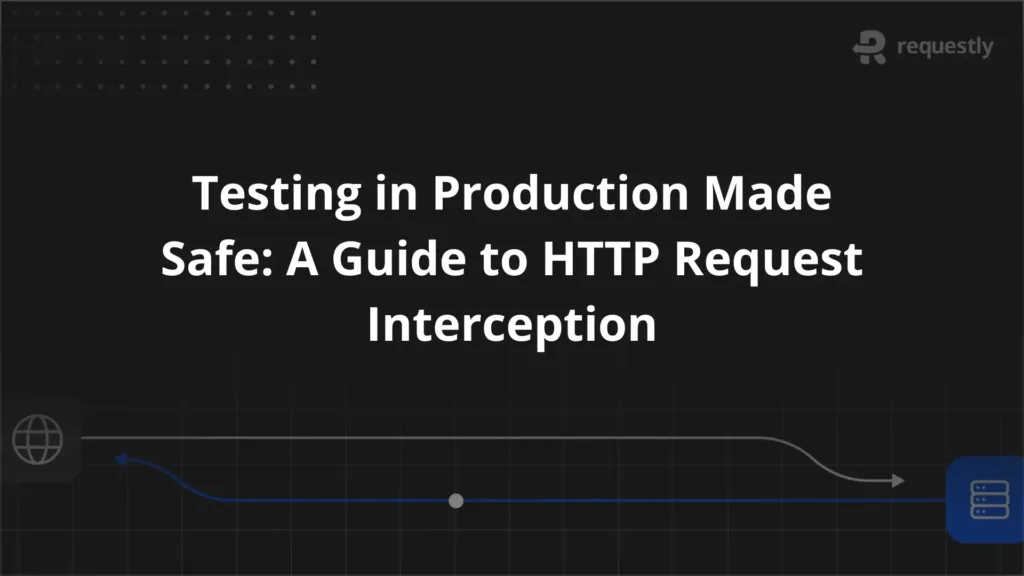How to implement Axios Interceptor in React?

Introduction
Axios is a popular javascript library that simplifies the process of sending HTTP requests to servers. It’s interceptor is a powerful feature that enables our app to intercept requests and responses. Axios interceptor helps us define functions that will be executed for each request or response before they are handled over to the application. This is usefu for activities such as adding authentication tokens, logging, and handling errors on a global scale, which makes our code cleaner and easier to manage.
In this blog post, we’ll learn how to implement Axios request interceptors in a React application. We’ll start by setting up Axios, and then we’ll see how to create and use request and response interceptors. By the end, you’ll know how to use interceptors to improve your application and keep your code organized.
Setup the project
Before diving into how to implement Axios request interceptors in a React application, make sure you have the following:
- Node.js and npm/yarn Installed: Ensure you have Node.js and npm (or yarn) installed on your machine. You can download Node.js from here.
- A React Project Setup: You should have a React project setup. If you don’t have one, you can create a new React project using Create React App:
npm create vite@latest my-axios-app --template react cd my-axios-app - Install Axios: Axios should be installed in your React project. You can install Axios using npm or yarn:
npm install axiosoryarn instal axios
Implementing Request Interceptors in Axios
Request interceptors in Axios allow you to modify requests before they are sent to the server. This can be useful for adding authentication tokens, setting custom headers, or logging requests. Let’s see how to implement Axios request interceptors in a React application.
Step 1: Create an Axios Instance
Create a new file axiosInstance.js, you can add a request interceptor to the Axios instance you created earlier. This interceptor will be executed before every request is sent out.
Creating an Axios instance allows you to set default configurations, such as the base URL and headers, that will be applied to all requests made with that instance. This helps in keeping your code DRY (Don’t Repeat Yourself).
Create a new file named axiosInstance.js (or any name you prefer) in your src folder and set up your Axios instance:
import axios from 'axios';
const axiosInstance = axios.create({
baseURL: 'https://dummyjson.com', // Replace with your API base URL
timeout: 1000,
headers: { 'Content-Type': 'application/json' }
}); // Create the axios instance
// Add a request interceptor
axiosInstance.interceptors.request.use(
function (config) {
// Do something before the request is sent
// For example, add an authentication token to the headers
const token = localStorage.getItem('authToken'); // taking auth token from local Storage
if (token) {
config.headers.Authorization = `Bearer ${token}`;
}
return config;
},
function (error) {
// Handle the error
return Promise.reject(error);
}
);
Here’s a summary of what we’ve done:
- Created an Axios instance using axios.create().
- Set the
baseURLto the base URL of your API. You can adjust this to match your API’s configuration. - Used interceptors.request.use() to intercept and modify outgoing requests. This allows us to add headers, authentication tokens, or make other changes to the request configuration.
Step 2: Use the Axios Instance in React Components
With the request interceptor set up, you can use the Axios instance in your React components as usual. The interceptor will automatically add the token (or perform any other configured actions) before each request is sent.
// src/App.js
import React, { useEffect, useState } from 'react';
import axiosInstance from './axiosInstance';
function App() {
const [data, setData] = useState(null);
useEffect(() => {
axiosInstance.get('/products/1') // Replace with your API endpoint
.then(response => {
setData(response.data);
})
.catch(error => {
console.error('Error fetching data:', error);
});
}, []);
return (
<div className="App">
<h1>Data from API</h1>
{data ? (
<pre>{JSON.stringify(data, null)}</pre>) : (<p>Loading...</p> )}</div> );
} export default App; 
As you can see In this example, the request to the API endpoint will include the authorization token in the headers, thanks to the request interceptor.
Step 3: Customizing the Interceptor
You can customize the request interceptor to perform other actions as needed. For example, you might want to log the details of each request:
axiosInstance.interceptors.request.use(
function (config) {
// Log the request details
console.log('Request:', config);
return config;
},
function (error) {
// Handle the error
return Promise.reject(error);
}
);
This setup will log the details of each request to the console, which can be helpful for debugging purposes.

By implementing request interceptors in your React application, you can ensure that all requests are consistently modified or enhanced before they are sent, improving the maintainability and functionality of your code.
Implementing Response Interceptor
Just as request interceptors allow you to manipulate outgoing requests, response interceptors in Axios provide the ability to handle responses globally before they reach your application code. This can be particularly useful for tasks such as error handling, response transformation, and logging. Let’s delve into how to implement response interceptors in a React application using Axios.
Step 1: Create the Response Interceptor
In your axiosInstance.js file, you can add a response interceptor to the Axios instance you created. This interceptor will be executed after every response is received. Now adding to the previous code
// src/axiosInstance.js
import axios from 'axios';
const axiosInstance = axios.create({
baseURL: 'https://dummyjson.com', // Replace with your API base URL
timeout: 1000,
headers: { 'Content-Type': 'application/json' }
});
// Add a request interceptor
axiosInstance.interceptors.request.use(
function (config) {
// Do something before the request is sent
const token = localStorage.getItem('authToken'); // Retrieve auth token from localStorage
if (token) {
config.headers.Authorization = `Bearer ${token}`;
}
return config;
},
function (error) {
// Handle the error
return Promise.reject(error);
}
);
// Add a response interceptor
axiosInstance.interceptors.response.use(
function (response) {
// Do something with the response data
console.log('Response:', response);
return response;
},
function (error) {
// Handle the response error
if (error.response && error.response.status === 401) {
// Handle unauthorized error
console.error('Unauthorized, logging out...');
// Perform any logout actions or redirect to login page
}
return Promise.reject(error);
}
);
export default axiosInstance;
}
}
Step 2: Use the Axios Instance in React Components
With the response interceptor set up, you can use the Axios instance in your React components as usual. The interceptor will automatically handle responses and errors based on your configuration.
// src/App.js
import React, { useEffect, useState } from 'react';
import axiosInstance from './axiosInstance';
function App() {
const [data, setData] = useState(null);
useEffect(() => {
axiosInstance.get('/products/1') // Replace with your API endpoint
.then(response => {
setData(response.data);
})
.catch(error => {
console.error('Error fetching data:', error);
});
}, []);
return (
<div className="App">
<h1>Data from API</h1>
{data ? (
<pre>{JSON.stringify(data, null)}</pre>) : (<p>Loading...</p> )}</div> );
} export default App;
}
} 
By implementing response interceptors in your React application, you can centralize response handling, improving code maintainability and application robustness. Whether it’s logging, transforming data, or managing errors, response interceptors provide a powerful way to manage HTTP responses efficiently.
Framework-Independent Alternative: Using Requestly
While Axios has powerful tools for processing HTTP requests within applications, integrating and managing interceptors directly within your codebase can be difficult and demand changes to your application’s architecture. Instead of depending on framework-specific solutions such as Axios interceptors, developers can use Requestly, a browser extension that modifies network requests and responses without requiring any changes to the application’s code. This method has various advantages over standard interceptors:
Simplifying Modifications with Requestly
- No Code Changes Required: Unlike implementing interceptors in your application code, which requires understanding and modifying the codebase, Requestly operates entirely from the browser. This means developers can modify requests and responses dynamically without touching the application’s source code.
- Flexibility Across Technologies: Requestly’s framework-independent nature allows it to work seamlessly across different projects and technologies. Whether you’re working with React, Angular, Vue.js, or any other framework, Requestly provides a consistent interface for managing network traffic.
Advantages of Using Requestly
- Ease of Use: Requestly simplifies the process of modifying network requests and responses through an intuitive browser extension interface. This accessibility makes it ideal for developers of all skill levels, from beginners to advanced users.
- Immediate Testing and Debugging: With Requestly, developers can instantly test and debug different scenarios by altering headers, URLs, or response content. This capability speeds up development cycles and enhances troubleshooting efficiency.
- Enhanced Privacy and Security: Requestly empowers developers to block or modify requests to enhance privacy, security, and compliance with data protection regulations. For instance, blocking tracking scripts or adding secure headers can be done effortlessly.
Example Use Cases
- Modify Server Response: Modify response content to simulate various server behaviors without backend changes.
- Testing Different API Requests: Dynamically alter request to test different API endpoints or data payloads.
- Blocking Network Request : Test your website under scenarios where certain external resources are unavailable
- Adding Custom Headers: Add authentication tokens or custom CORS headers for testing APIs that require specific headers.
How to use Requestly Interceptor
Modify API Response
Requestly allows you to modify API responses. It provides a user-friendly interface for overriding the response body of API requests, allowing you to mimic different data scenarios that your frontend might encounter.
Insert/Inject Script
Insert/Inject Script Rule allows you to inject JavaScript and CSS into web pages as they load. This means you can modify the DOM, change styles, or even add new functionality without altering the source code directly. It’s important for testing hypotheses or debugging during the development and quality assurance process. Learn more about it here.
Replace Rule
Replace Rule enables you to replace a String in URL with another String. This feature is particularly useful for developers to swap the API endpoints from one environment to another or change something specific in the URL. Requests are matched with source condition, and find and replace are performed on those requests by redirecting to the resulting URL. Learn more about this rule here.
Conclusion
In this blog post, we’ve explored the powerful concept of Intercepting requests with Axios in React which allows us developers to have more control over our HTTP requests and responses within their applications, Whether it’s adding authentication tokens, logging requests for debugging purposes, or handling errors globally, Axios interceptors provide a flexible solution to meet diverse development needs.
Frequently Asked Questions
What is an Axios interceptor used for in React?
Axios interceptors let you run custom logic before a request is sent or before a response reaches your component. They are commonly used for adding auth tokens, logging, transforming data, and global error handling.
Why should I create a custom Axios instance?
A custom instance allows you to define shared settings like base URLs, headers, and interceptors in one place. This avoids repeating configurations and keeps code clean and maintainable.
How do request interceptors help with authentication?
Request interceptors can automatically attach tokens from localStorage or cookies to the Authorization header, ensuring every request includes valid credentials without modifying components.
What can I do with a response interceptor?
Response interceptors help with global error handling, logging, response transformation, retry logic, and handling cases like 401 unauthorized errors.
Do interceptors run for every request automatically?
Yes. Once added to an Axios instance, the interceptor logic executes for every relevant request or response without needing changes in the component code.
Can Axios interceptors replace debugging tools like Requestly?
No. Axios interceptors only work inside your application code. Requestly works outside your app and can modify, block, mock, or rewrite requests without touching the codebase.
When should I use Requestly instead of interceptors?
Use Requestly when you need zero-code modifications, want to test alternate API responses, simulate failures or latency, experiment with headers, or debug production behavior without deploying code changes.
Contents
- Introduction
- Setup the project
- Implementing Request Interceptors in Axios
- Step 1: Create an Axios Instance
- Step 2: Use the Axios Instance in React Components
- Data from API
- Step 3: Customizing the Interceptor
- Implementing Response Interceptor
- Step 1: Create the Response Interceptor
- Step 2: Use the Axios Instance in React Components
- Data from API
- Framework-Independent Alternative: Using Requestly
- Simplifying Modifications with Requestly
- Advantages of Using Requestly
- Example Use Cases
- How to use Requestly Interceptor
- Modify API Response
- Insert/Inject Script
- Conclusion
- Frequently Asked Questions
- Replace Rule
- What is an Axios interceptor used for in React?
- Why should I create a custom Axios instance?
- How do request interceptors help with authentication?
- What can I do with a response interceptor?
- Do interceptors run for every request automatically?
- Can Axios interceptors replace debugging tools like Requestly?
- When should I use Requestly instead of interceptors?
Subscribe for latest updates
Share this article
Related posts





















